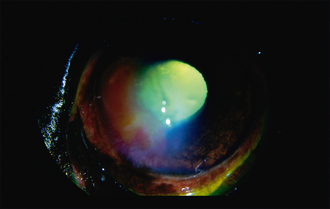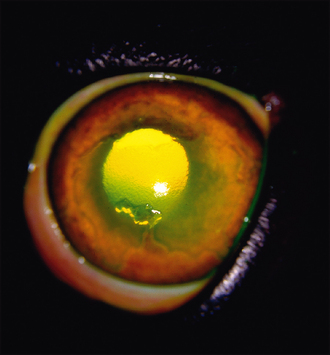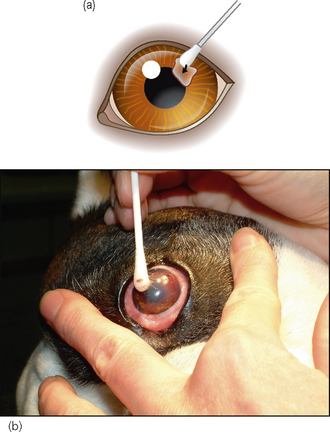21 Recurrent epithelial erosion
CLINICAL EXAMINATION
A full ophthalmic examination should be performed on both eyes. Conjunctival hyperaemia and increased lacrimation are the typical abnormalities present. The degree of blepharospasm is variable. As with all patients presenting with ocular surface disease, Schirmer tear test readings should be taken from both eyes. It is usual for the affected eye to have a higher reading. The patch of ulceration might be visible with the naked eye but it is important to test both eyes with fluorescein – and to flush the excess away properly with sterile saline. Typically the ulcer has an irregular outline with under-run edges – the fluorescein leaches under the loose epithelium (Figure 21.1). This lip of non-adherent epithelium is pathognomonic for the non-healing ulcer. Also by their nature these ulcers are extremely shallow – it is only the epithelium that is denuded, the stroma remains intact.
There may be evidence of corneal vascularization – fine branching vessels from the limbus nearest to the ulcer (Figure 21.2). If the case is presented late in the course of the disease this vascularization might be abundant, producing an obvious granulation reaction and the owner’s complaint of a red eye. If the case is complicated by secondary bacterial infection, the discharge will be mucopurulent in nature – although usually it is purely serous. Occasionally corneal oedema is present in the ulcerated area and adjacent tissue but this is not usually a particularly obvious clinical sign. Normally there is no intraocular involvement, although mild miosis might be apparent due to a reflex uveitis. This is more likely in long-standing cases, or when the patient seems particularly uncomfortable – the spasm of the iris constrictor muscle will cause ocular pain.

Figure 21.2 Another epithelial erosion, also in a boxer, with moderate corneal vascularization and some corneal oedema.
TREATMENT OPTIONS – MEDICAL/SURGICAL
Debridement of any loose epithelium is fundamental to achieving healing. This is normally performed under topical anaesthesia and should be performed on initial presentation – the characteristic lip of non-adherent epithelium needs to be removed before normal adhesion can occur. If the patient is fractious or the eye particularly painful, then sedation might be required; however, this is rarely necessary. One drop of topical anaesthetic is applied (e.g. proxymetacaine) and repeated 5 minutes later. The patient’s head is held still and a dry, preferably sterile, cotton bud is used to remove all loose epithelium. The cotton bud can be gently rubbed over the ulcer and rolled at the edges to pull off the thin, loose tissue (Figure 21.4). Each time the tip becomes moist it should be replaced with a new cotton bud. Normally three to five are required to fully debride the ulcer. This will enlarge the ulcer significantly and it is important to explain this to the owners – it is quite usual to double or even triple the size of the erosion just with simple debridement.
Stay updated, free articles. Join our Telegram channel

Full access? Get Clinical Tree




